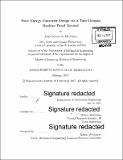Wave energy converter design via a time-domain Rankine panel method
Author(s)
Seixas de Medeiros, João
DownloadFull printable version (13.49Mb)
Other Contributors
Massachusetts Institute of Technology. Department of Mechanical Engineering.
Advisor
Stefano Brizzolara.
Terms of use
Metadata
Show full item recordAbstract
Efficient design of energy converters heavily depends on the capacity of the designer to accurately predict the device's dynamic, which ultimately leads to the power extraction. This is specially true for wave energy converters (WEC), which usually present a high cost per kWh generated. In this thesis a particular WEC which uses a rotating mass for power extraction is studied. A numerical model for the prediction of its motion and power extraction is presented. The nonlinear dynamic model consists of a time-domain three dimensional Rankine panel method coupled, in the time integration, with a MATLAB algorithm which solves for the equations of the gyroscope and Power Take-Off (PTO). The former acts as a force block, calculating the forces due to the waves on the hull, which is then sent to the latter through TCP/IP, which couples the external dynamics and performs the time-integration using a 4th order Runge-Kutta method. With the proposed code, two case studies are examined. The first consists of two gyroscopes, rotating in opposite directions, to negate undesirable yaw effects on the WEC's hull. The device's optimum PTO damping value and flywheel spin are then shown, which change for different sea states. The second is a comparison against results from experimental testing of a 1:50 model at the Davidson Laboratory during the Wave Energy Prize.
Description
Thesis: S.M., Massachusetts Institute of Technology, Department of Mechanical Engineering, 2017. Cataloged from PDF version of thesis. Includes bibliographical references (pages 111-115).
Date issued
2017Department
Massachusetts Institute of Technology. Department of Mechanical EngineeringPublisher
Massachusetts Institute of Technology
Keywords
Mechanical Engineering.